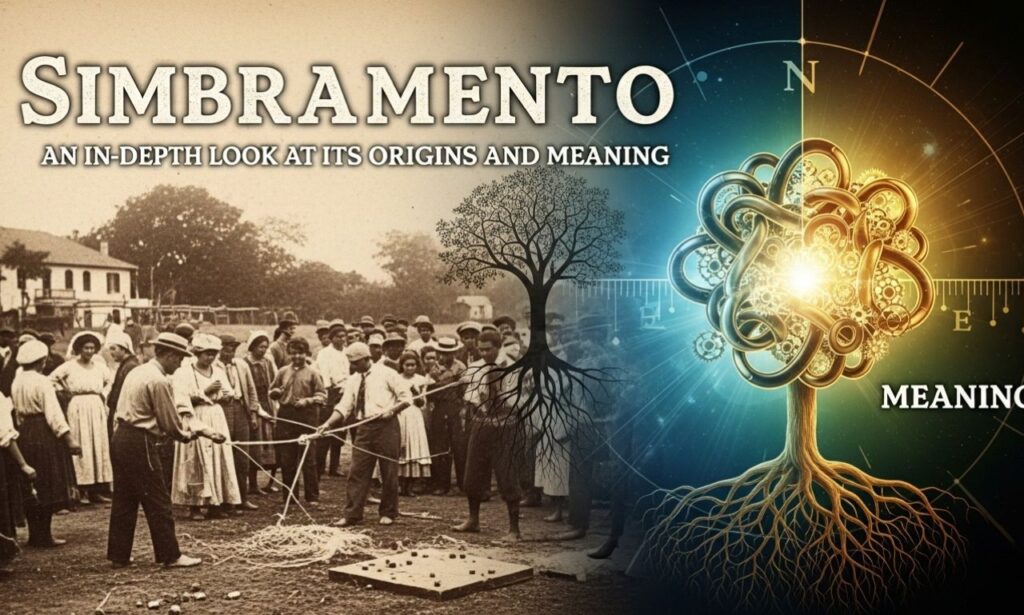Simbramento is a word that resonates with mystery and tradition. For those unfamiliar, it may seem like just another term lost in the annals of cultural practices. However, simbramento offers a rich tapestry woven from history, rituals, and profound significance. This fascinating concept has deep roots in various communities, embodying values and beliefs that have stood the test of time.
As we dive into this exploration, you’ll discover what simbramento truly means and how its origins trace back to ancient customs. Its cultural relevance extends beyond mere practice; it influences modern interpretations while sparking intriguing discussions about its role in today’s society. Get ready to embark on a journey through time—a journey that unveils the layers of simbramento!
What is Simbramento?
Simbramento is a rich cultural phenomenon rooted in deep traditions. Its essence captures the intersection of spirituality and community bonding.
At its core, simbramento signifies an act of homage or respect towards ancestors. This practice often involves rituals that connect individuals with their heritage. Participants engage in ceremonies that foster collective memory and identity.
The process varies by region, influenced by local customs and beliefs. Yet, the underlying theme remains constant: honoring those who came before us.
Through music, dance, or storytelling, simbramento becomes a vibrant expression of shared values and experiences within communities.
This unique practice invites introspection as well as celebration. It serves to remind people of their origins while reinforcing social ties among participants.
The History of Simbramento
Simbramento has roots deeply embedded in ancient traditions. Its origins can be traced back centuries, primarily within indigenous communities. These societies celebrated the changing seasons and agricultural cycles through unique practices.
Historically, simbramento served as a way to honor nature’s gifts. Rituals were often linked to fertility and harvest, marking crucial moments in the agricultural calendar. Elders played a vital role in passing down stories related to these ceremonies.
As time progressed, simbramento evolved into more formalized events. The blending of cultures contributed to its rich tapestry. New interpretations emerged while still respecting foundational elements from earlier times.
The influence of colonization couldn’t be ignored either. Many aspects of simbramento adapted under new societal pressures but retained core beliefs that resonate today. This resilience showcases the enduring spirit associated with these rituals throughout history.
Cultural Significance of Simbramento
Simbramento holds deep cultural significance in various communities. It serves as a bridge connecting past traditions with contemporary values.
This unique practice embodies shared beliefs and collective identity. Through simbramento, participants engage in time-honored rituals that celebrate their heritage.
The symbolism associated with reflects resilience and unity among its practitioners. It fosters a sense of belonging, reinforcing social ties within groups.
Festivals featuring simbramento often showcase local art forms such as music, dance, and storytelling. These elements enhance the experience while preserving cultural narratives for future generations.
Moreover, simbramento acts as a medium for intergenerational dialogue. Elders pass down wisdom to younger members through participation in these significant events.
As society evolves, so does the interpretation of simbramento. New influences blend with traditional practices, ensuring it remains relevant while still honoring its roots.
The Rituals and Traditions Associated with Simbramento
Simbramento is steeped in rich rituals that reflect its deep cultural roots. One of the most notable traditions involves a communal gathering, where participants wear traditional attire, symbolizing unity and shared purpose.
During these gatherings, music plays a pivotal role. Local musicians often perform folk tunes that have been passed down through generations. The melodies evoke emotions tied to the history and essence of Simbramento.
Another significant ritual includes storytelling sessions around bonfires. Elders recount tales from the past, weaving together lessons and morals that resonate with contemporary life.
Food also holds an important place in these celebrations. Special dishes are prepared using ancestral recipes, allowing families to connect with their heritage while sharing meals together.
Through these practices, Simbramento fosters community bonds and preserves collective memories for future generations. Each ritual serves as both homage to the past and a celebration of identity in modern times.
Modern Interpretations and Practices of Simbramento
Modern interpretations of simbramento have evolved, blending traditional beliefs with contemporary practices. Today, many participate in these rituals not only as a nod to cultural heritage but also as a means of personal expression.
Some practitioners emphasize mindfulness and community connection during the ceremonies. They believe that fosters unity among participants. This has led to new forms of gatherings where people share stories and experiences related to their roots.
Social media plays a significant role in shaping modern celebrations. Online platforms allow individuals to showcase their unique interpretations, often leading to creative adaptations that honor the original spirit while making it accessible for younger generations.
Workshops and seminars focusing on the nuances of simbramento are becoming more common. These events encourage dialogue about its meaning today, allowing for an ongoing exploration of identity within this ancient practice without losing touch with its origins.
Controversies Surrounding Simbramento
Simbramento, while rich in tradition, is not without its controversies. Critics argue that some practices can be harmful or exploitative. Discussions concerning the ethics of certain rituals often spark heated debates.
Cultural appropriation also plays a significant role in these discussions. As gains popularity outside its traditional context, questions arise about respect and authenticity. Many advocate for preserving original meanings rather than diluting them for modern interpretations.
Additionally, there are concerns regarding commercialization. Some fear that as becomes more mainstream, it risks losing its spiritual essence to profit-driven motives. This has led to calls for responsible engagement with the practice.
Social media further complicates perceptions of simbramento. Viral trends sometimes misrepresent or oversimplify complex customs, leading to misunderstandings among those unfamiliar with the tradition’s true significance.
How Simbramento Continues to Impact Society Today
Simbramento leaves a profound mark on contemporary society. Its influence can be seen in various cultural expressions, from art to literature. Many artists draw inspiration from the rich symbolism associated with, creating works that resonate deeply with collective memories.
Communities engage in discussions around simbramento as they seek to understand their roots. This exploration fosters a sense of belonging among individuals who share similar backgrounds and traditions.
Moreover, modern adaptations of promote social awareness. They encourage conversations about identity, heritage, and change within rapidly evolving societies.
As people navigate globalization’s challenges, the essence of simbramento serves as a grounding force. It reminds them of their unique narratives while embracing broader human experiences.
Through festivals or community gatherings celebrating this tradition today, connections are formed across generations—bridging past and present in meaningful ways.
Conclusion
Simbramento is a rich tapestry woven from history, culture, and community. Its origins are steeped in tradition, reflecting the values and beliefs of those who practice it. As we explored its significance, we saw how this ritual has evolved over time while still holding onto its core essence.
Today, Simbraento continues to resonate with many individuals seeking connection to their heritage. The rituals associated with it foster a sense of belonging and continuity. Yet, as society changes, so too does the interpretation of these practices.
Controversies surrounding highlight the ongoing discussions about cultural appropriation versus appreciation. This dialogue invites us to reflect on our own understanding of such traditions.
As generations pass down stories and experiences tied to Simbramento, they ensure that its spirit remains vibrant. Whether through modern adaptations or traditional ceremonies, this practice will likely continue influencing communities for years to come. It represents more than just a ritual; it embodies resilience and identity in an ever-changing world.






